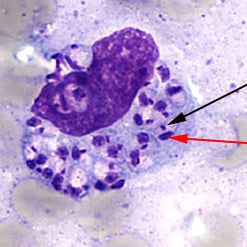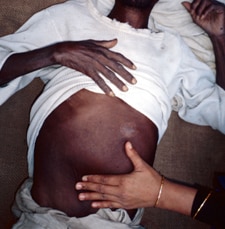Direct Visualization:
A definitive diagnosis of visceral leishmaniasis can be made based on visualization of amastigotes on microscopic examination of Giemsa-stained aspirate from bone marrow, blood, lymph or spleen (the most accurate but also most dangerous due to bleeding complications). The amastigotes are seen in monocytes or macrophages. This method of diagnostic testing however is expensive, complicated and not appropriate for many of the settings in which visceral leishmaniasis is endemic. The search for a cheap, specific and sensitive field test is ongoing.
Serological Tests:
- Several antibody-detection tests exist and are available for field diagnosis. Although these tests when combined with presentation of clinical signs and symptoms are enough to lead to a safe decision to treat they are not useful for assessing for cure after treatment. These tests are also unreliable in patients who have been treated and later return with symptoms such as fever and splenomegaly as antibodies will be present and the test can’t distinguish between a relapse of visceral leishmaniasis and another pathology.
- A direct agglutination test (DAT) is available and has both a high sensitivity and high specificity; however it is technically demanding and requires an 8 hour incubation period.
- An enzyme-linked immunosorbent assay (ELISA) and immunochromatographic strip test based on a 39-amino-acid-repeat recombinant leishmanial (rK39) antigen has proven a better alternative for field testing. It can also be used after treatment and levels decrease rapidly.
Urine Tests:
- A latex agglutination test (KAtex) which detects antigen in a patient’s urine has shown promise but is continuing to be evaluated.
Molecular Diagnostics:
- There are several tests but they are complex and expensive and so are limited to research centers and some teaching hospitals and are not widely used to diagnose patients in many endemic areas.

Bone marrow biopsy specimen from a patient
with visceral leishmaniasis showing a macrophage
containing Leishmania amastigotes. CDC photo

Bone marrow biopsy specimen from a patient
with visceral leishmaniasis showing a macrophage
containing Leishmania amastigotes. CDC photo
